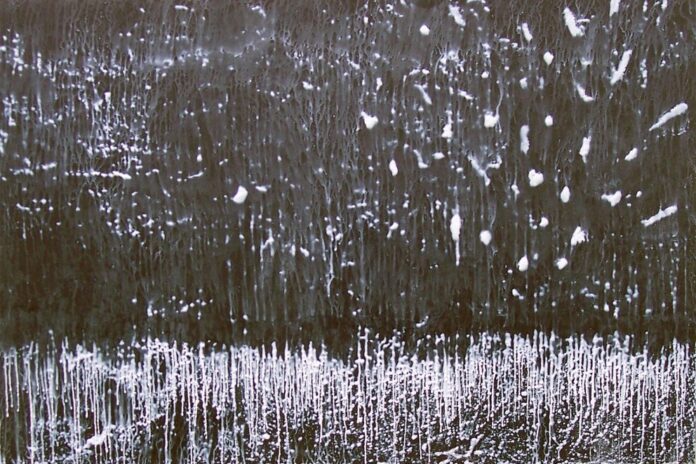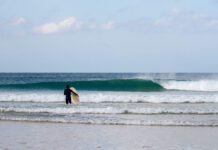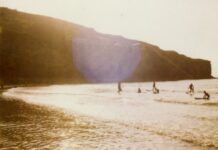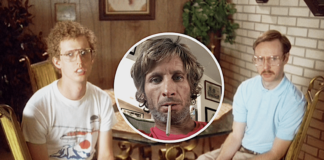With that, we get into our cars, cross the main road, and drive a few minutes inland to Ben’s home and studio. His studio is their double garage; at Christmas time when so many homeowners across western world cover the outsides of their homes with gaudy fairy lights and illuminated models of Santa Claus, it is strung with white fairy lights spelling out the phrase “Save The Waves”. If there’s an opportunity to subvert popular or surf culture and make a statement, then this artist is unlikely to let it pass by. We have a cup of tea in the family living room – a large double height extension on the side of the historic cottage that was built by the previous owner, an opera singer and music teacher, as a classroom and practice space. Built for its acoustics, it also provides an incredible gallery setting for the current owner’s work. The walls of this space are ever-evolving, as Ben hangs new work before it goes off to be exhibited, or takes old pieces out of storage to enjoy afresh. He was advised long ago to always keep the first of a series or the original of one-off works, so whilst his work is exhibited, sold and collected, the best collection belongs to the artist himself. It’s an amazing space to stand and soak in over fifteen years of surf art. We move out to the studio so that I can se what he’s working on at the moment. The garage has a surfboard rack and bikes inside the door, with the other half a dedicated, dusty work space. There’s a window in the back wall, misted with cobwebs because it’s hard to reach over the workbench covered in artists tools and ephemera, which looks out over a field of summer wheat. On the opposite wall is a large “canvas” in progress – a panel covered with different pieces of neoprene that Ben tells me will eventually depict a town on the Cornish coast, with a fishing harbour, taped seams as the higgledy-piggeldy lanes and roads that characterise the historic coastal settlements around here, and a zipper train track. We talk about the arc of his career to date, and how he’s found himself circling back to the found paintings concept. Twenty years ago when he lived and worked in Manchester in the UK’s north west, a large city with a strong industrial heritage that’s probably further metaphorically from the rural south westernmost county that he now calls home than it is geographically, Cook was an established fine artist and art school lecturer. His studio was on the top floor of an old textile mill – Manchester was the world’s first industrialised city and it grew off the back of textile production – and he began stretching and painting on cheap fabric, often purchasing his “canvases” from reject fabric shops. That work progressed to the point where he stopped painting on the fabric, instead stretching and repurposing fabric that had been misprinted, such as material for football kits with a team’s colours and patterns that, as an ink had run out or as a crease or fold went through the machine, had imperfections such as wobbles or breaks in the pattern or strange colour bleeds. Cook saw these as painterly marks rather than imperfections, and presented them as such. “I called them Found Paintings in reference to the “objet trouvé” trend in the British art world that saw contemporary artists taking found objects and exhibiting them, as-is, in a gallery setting, however they’re works that I’ve had some authorship over, re-shaping, stretching and re-presenting them as paintings. I was a painter and at that time I still considered myself a painter, so it was up to the person looking at the work to decide whether what they were looking at was a painting or not”.
Two decades on, it is a technique that he has inadvertently returned to using discarded wetsuits, creating his “neoscapes”, rather than rejected football jersey material.





